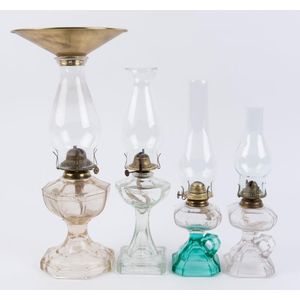Set of Four Pressed Glass Kerosene Table Lamps
Four pressed glass kerosene table lamps, two with Greek key pattern border to the faceted octagonal fonts on column stands with stepped bases, the smaller two in clear and two tone clear and green glass with carrying handles, each with single brass burners and glass chimneys, early 20th century, (4 items), the taller 45 cm high,
You must be a subscriber, and be logged in to view price and dealer details.
Subscribe Now to view actual auction price for this item
When you subscribe, you have the option of setting the currency in which to display prices to $Au, $US, $NZ or Stg.
This item has been sold, and the description, image and price are for reference purposes only.
- Greek Key Pattern - The Greek key pattern is a decorative design that consists of continuous interlocking vertical and right-angled lines that form a repeating motif. It is also known as "Meander" or "Greek fret." The pattern is thought to have originated in ancient Greece, where it was used in various decorative arts, such as pottery, metalwork, and architectural elements. The Greek key design is widely used in a variety of contexts, including classical architecture, decorative arts, furniture, interior design and textiles. The pattern is considered timeless and classic, and its geometric simplicity makes it a popular choice for designers in many different fields.
- Pressed Glass - Pressed glass is a type of glassware that is produced by pressing molten glass into a mould. This manufacturing process involves using a mould to shape and form the glass while it is still in a semi-liquid or molten state. The glass is pressed into the mould to take on its design and texture.
The use of moulds allows for the mass production of glass items with consistent designs. Pressed glass became popular in the 19th century as a more economical alternative to hand-blown glass, as it allowed for faster and more efficient production. This method was widely used for creating various glass objects, including dishes, bowls, vases, and decorative items.
Pressed glass can have intricate patterns and designs, and it has been used for both utilitarian and decorative purposes. While it may not have the same artisanal quality as hand-blown glass, pressed glass has its own charm and has been a significant part of glassware history.
This item has been included into following indexes:
